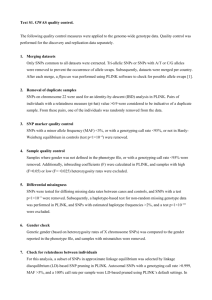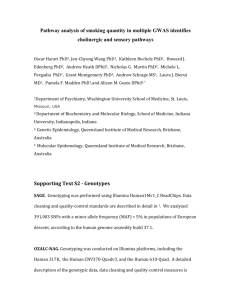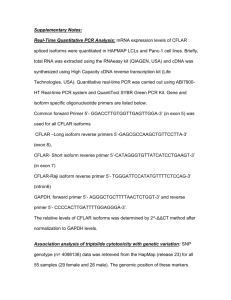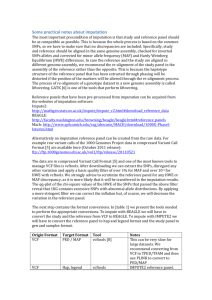Supporting Information - Nederlands Tweelingen Register
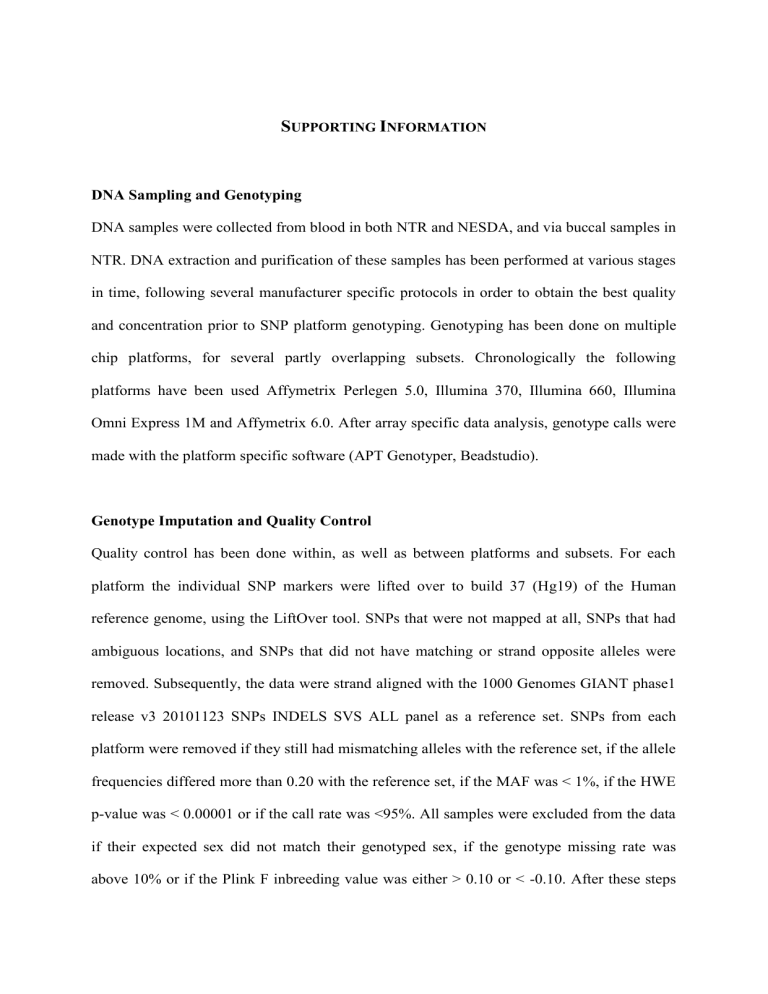
S UPPORTING I NFORMATION
DNA Sampling and Genotyping
DNA samples were collected from blood in both NTR and NESDA, and via buccal samples in
NTR. DNA extraction and purification of these samples has been performed at various stages in time, following several manufacturer specific protocols in order to obtain the best quality and concentration prior to SNP platform genotyping. Genotyping has been done on multiple chip platforms, for several partly overlapping subsets. Chronologically the following platforms have been used Affymetrix Perlegen 5.0, Illumina 370, Illumina 660, Illumina
Omni Express 1M and Affymetrix 6.0. After array specific data analysis, genotype calls were made with the platform specific software (APT Genotyper, Beadstudio).
Genotype Imputation and Quality Control
Quality control has been done within, as well as between platforms and subsets. For each platform the individual SNP markers were lifted over to build 37 (Hg19) of the Human reference genome, using the LiftOver tool. SNPs that were not mapped at all, SNPs that had ambiguous locations, and SNPs that did not have matching or strand opposite alleles were removed. Subsequently, the data were strand aligned with the 1000 Genomes GIANT phase1 release v3 20101123 SNPs INDELS SVS ALL panel as a reference set. SNPs from each platform were removed if they still had mismatching alleles with the reference set, if the allele frequencies differed more than 0.20 with the reference set, if the MAF was < 1%, if the HWE p-value was < 0.00001 or if the call rate was <95%. All samples were excluded from the data if their expected sex did not match their genotyped sex, if the genotype missing rate was above 10% or if the Plink F inbreeding value was either > 0.10 or < -0.10. After these steps
between all possible individual pairs and compared to the expected family structure of the
NTR study. Samples were removed if the data did not match the expected IBS sharing. DNA samples that were typed on multiple platforms were tested if the overlapping SNPs had a concordance rate above 99.0%. In case this was not true we removed all data of these samples. Subsequently, from each MZ twin pair a single DNA sample was selected for imputation leaving a total of 12240 unique DNA samples to be imputed. On the merged data, the HWE and MAF SNP filters were re-applied, as well as the reference allele frequency difference <0.20 checks. As a final prior step to imputation SNPs with C/G and A/T allele combinations were removed if the MAF was between 0.35 and 0.50 to avoid wrong strand alignment for these SNPs.
Phasing of all samples and imputing cross-missing platform SNPs was done with MACH 1.0.
The phased data was then imputed with Minimac in batches of around 500 individuals for 561 chromosome chunks obtained by the CHUNKCHROMOSOME program. After imputation,
DNA confirmed MZ twins were re-duplicated back into the data resulting in a total dataset of
14.003 individuals for the 1000 genomes reference. The format of the data was transformed to the basic three probabilities SNPTEST gen.gz format, as this is the most general applicable format for the subsequent genomic analyses tools. After imputation, SNPs were filtered based on the Mendelian error rate in families, Hardy-Weinberg Equilibrium , imputation quality R
2 and MAF. HWE was calculated on the SNPTEST summed genotype probability counts for the full sample and SNPs were removed if the p-value < 0.00001. The Mendelian error rate was calculated on the best guess genotypes in families (trios and sib-pairs with parents) using first Gtool for best guess and then Plink 1.07. SNPs were removed if the Mendelian error rate was above 2%. SNPs were filtered from the dataset if the imputation quality INFO < 0.40 and
if the MAF in the total sample was less than 0.01. Finally SNPs were also removed if the imputed allele frequency differing more than 0.15 from the 1000G reference allele frequency, which left 6.464.174 post QC SNPs with a mean R2 of 0.92.
Statistical analysis
Heritability
First a series of models was evaluated with a baseline model, which included 9 parameters: the correlations between MZM, DZM, MZF, DZF and DOS twin pairs, a threshold for males and females and two regression coefficient for fixed effects of age on both thresholds. In model 2 the age effect on the threshold was dropped, while in model 3 the thresholds were constrained to be equal between men and women. In model 4 we tested if the correlations of male and female MZ twin pairs (r mzm
=r mzf
) and the correlations in dizygotic twin pairs could be constrained to be equal (r dzm
=r dzf
=r dos
) (Vink and others 2012). Guided by the results from the saturated model, a
decomposition of the total variance into Additive genetic (A), Common (C) and unique environmental variance (E) components was fitted to the data from twins. We tested whether variance components due to C and A were significantly different from zero and also tested if both could be dropped simultaneously. All data were included in the analyses, and raw-data maximum likelihood estimating as implemented in Mx was used to fit the saturated and the genetic models to the data. Testing of models was done by likelihood-ratio tests, by subtracting the negative log-likelihood (-2LL) for the more restricted model from the -2LL for the more general model. This yields a statistic that is distributed as chi-square with degrees of freedom
(df) equal to the difference in the number of parameters in the two models. If the difference test is significant (P<0.05) the constraints on the nested model cause a significant deterioration of the model.
SNP-heritability
Genetic relationship matrix (GRM) employed in GREML analysis was calculated based on
1000 Genome imputed SNPs of high quality (r
2
>=0.8), converted to Plink best guess format.
As was discussed in the section of DNA Sampling and Genotyping , our data set comprises several data sets genotyped on different platforms. In order to check and avoid systematic differences in allele frequencies between SNP platforms, we tested the association between each platform and other platforms by assigning samples in one platform as cases and samples in all other platforms as controls. SNPs that were significantly different in frequency (P <
0.00001) between cases and controls were removed from the data set. GRMs were built for each of 22 chromosomes and then merged into a single matrix. In total genetic relationships between samples in GRM were estimated from 6.325.240 SNPs.
R EFERENCES
Purcell S, Neale B, Todd-Brown K, Thomas L, Ferreira MA, Bender D, Maller J, Sklar P, de
Bakker PI, Daly MJ and others. 2007. PLINK: a tool set for whole-genome association and population-based linkage analyses. Am J Hum Genet 81(3):559-75.
Vink JM, Bartels M, van Beijsterveldt TC, van Dongen J, van Beek JH, Distel MA, de Moor MH,
Smit DJ, Minica CC, Ligthart L and others. 2012. Sex differences in genetic architecture of complex phenotypes? PLoS One 7(12):e47371.
